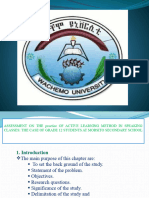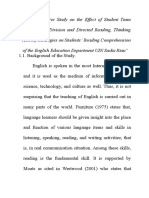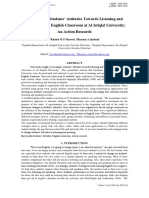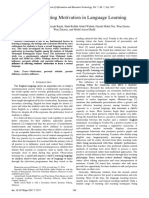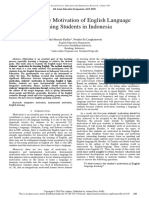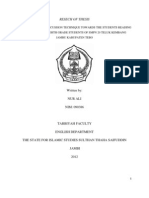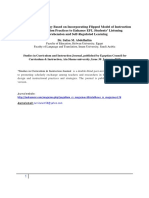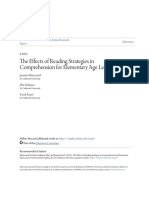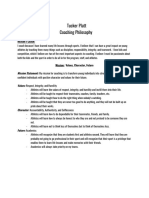Professional Documents
Culture Documents
EFL Students' Learning Styles and Their Effect On Listening Performance A Study at SMAN 2 Watansoppeng
Original Title
Copyright
Available Formats
Share this document
Did you find this document useful?
Is this content inappropriate?
Report this DocumentCopyright:
Available Formats
EFL Students' Learning Styles and Their Effect On Listening Performance A Study at SMAN 2 Watansoppeng
Copyright:
Available Formats
Volume 6, Issue 2, February – 2021 International Journal of Innovative Science and Research Technology
ISSN No:-2456-2165
EFL Students’ Learning Styles and Their Effect on
Listening Performance: A Study at
SMAN 2 Watansoppeng
Femy Rahmadani
Postgraduate Student of English Language Studies
Faculty of Cultural Sciences - Hasanuddin University
Makassar, South Sulawesi, Indonesia
Abidin Pammu Nasmilah
Faculty of Cultural Sciences Faculty of Cultural Sciences
Hasanuddin University Hasanuddin University
Makassar, South Sulawesi, Indonesia Makassar, South Sulawesi, Indonesia
Abstract:- Learning styles has revolved around EFL Whitehead [2] settles that this mission is important to the
contexts and has gained wider attention from teachers need for language skills as a necessary condition for people to
and teaching practitioners as well as researchers in have a resilient survival in this fast-changing community.
Indonesia and around the world. The primary purpose of Furthermore, in a large part of the world, English creates a
this research is to figure out if the learning style has a space that enables communication and debates to take place.
major impact on the listening performance of the
students. The design of the present research is a English has developed the international language and
quantitative research design that incorporates statistical used by most people all over the world. Engish is important to
tools. The study design employs causal comparative of ex learn for people, especially in the modern era [3]. It has been
post facto design. The research’s population was the taught in many countries either as a second language or
second-grade students of SMAN 2 Watansoppeng with a foreign language. Yufrizal et al [4] argue that learning success
total of 150 students taking only 27 students as the is measured by learning achievement and mastering language
sample. The instruments or tools were in the form of and language skill. In order to succeed in language learning,
questionnaires on learning style and listening the student is necessary to use their strategies. It can be shown
comprehension assessments. The data were analyzed by that, in the sense of learning, each student has a different way
using One-Way ANOVA in IBM SPSS 25.0. The result of of reacting to new knowledge. Therefore, many people named
the research showed that F-table score of learning style on learning style as a student's trait coping with strengths and
students’ listening performance is 0.159 and the deficiencies in taking and processing information. Naming and
significant value is 0.923. The values confirm that there is Hayati [5] stated that there are three kinds of learning styles,
no significant effect of learning style on students’ listening visual learning style, auditory learning style, and kinesthetic
performance. Moreover, it was found that auditory tend learning style. Visual student means learning by seeing or
to be the most dominant learning style. The finding hearing, auditory student means learning by listening, and
generates pedagogical concerns that teachers should not kinesthetic student means learning by touching or
worry about the differences of students learning styles experiencing, working, and moving.
since effective and productive teaching may be achieved
regardless of style variables. For both students and teachers, acquiring an
understanding of the learning habits of students may be very
Keywords:- EFL Students; Learning Styles And Effect; useful. Involving students in the constructive learning process
Listening Performance. involves knowing and respecting the learning patterns of
learners and the instructional styles of teachers. It is either
I. INTRODUCTION possible to balance or mismatch the two. Studying the bond
between them is vital. Many research on matching and
The government of Indonesia demands its people to mismatching cognitive patterns and instructional styles have
obtain a high standard of English in listening and other skills been done [6] [7]. Most of the research point to matching the
[1]. The government has become well aware of the need for two as having a positive effect on the success of the students
literacy skills to establish political and economic engagement and show that mismatching is the reverse.
with other countries. More recently, over the Department of
Education and Culture, the government of Indonesia has urged Learning style is not about intelligence or skills [8]. It is
its people worldwide to strengthen their literacy skills in order about the way the brain of a human works to effectively
to know how to encounter the globalization era's dynamic understand and get knowledge. Specifically, learning styles
growth. are found to affect the learning habits of the learners are
IJISRT21FEB060 www.ijisrt.com 162
Volume 6, Issue 2, February – 2021 International Journal of Innovative Science and Research Technology
ISSN No:-2456-2165
impaired in acquiring information. Speaking about achievement, but kinesthetic seems to be the better among
information, students get much information from listening. In other learning styles in reading comprehension achievement.
language instruction, listening also plays a major part. In order Furthermore, Hanafi [13] stated no significant difference
to accomplish the purpose of the program, it ensures that between students' learning style on their writing achievement.
teaching listening becomes an essential activity for English However, little has been done on revealing the effect of
teachers to do. learning style on listening skill. More compact research on this
matter will give us a clearer idea on how learning style affects
In assessing the success of students in learning language skill. This present study purposes to determine
environments, listening is also an important aspect. To assist whether there is any effect of learning style on the students'
them in the teaching and learning process, they require strong listening performance.
communication skills. Daweesh in Afriani [9] stated that The
value of listening comprehension in instructional II. LITERATURE REVIEW
environments should be understood by teachers and students.
A clear listening understanding, particularly for senior high A. The Concept of Learning Style
school students, will help the students understand the content In the mid-70s, the concept of multiple learning types
and get so much new feedback. As a result, possessing strong began to gain traction, and since then, the notion has affected
skills in listening comprehension will improve the academic the understanding of schooling and learning. Just as there are
performance of students. It is impossible for certain students numerous training methods, people often feel that there are
to develop listening because students have to pay a lot of various ways to learn and comprehend new knowledge.
attention, focus, and often feel asleep while listening. Despite criticism, many individuals began to look at the
multiple learning approaches and determine the favorite
In order to improve listening achievement, the student learning methods of their own pupils. Many parents of
should know their learning style. According to Hilliard in disadvantaged students who for the first time look at
Naning and Hayati [5], learning styles are the distinctive ways homeschooling as an instructional option typically continue
in which information is received, interpreted, and processed by learning more about the forms of modes of learning and
by a person. Students with different tastes in the learning style how children learn better.
will behave differently in the way they interpret, engage with,
and respond to the learning environment. This applies to Learning style analysis has become a major concern in
certain variables, one of which is their distinct way of most sector of education over the past fifteen years [14]. In
interpreting data from their listening. several different forms, learning styles can be defined,
categorized, and described. According to Hilliard [15],
There are some reviews of related research findings from learning styles are the characteristic ways individuals acquire,
the previous researchers, Afriani [9], in the same scope with perceive, and process information. It can be defined as a
learning style. Her research found that there is no essential collection of causes, behaviors, and attitudes that promote
connection between the learning style of students and their learning in any situation. How the teachers teach and the
success in listening skills. Each of the students who succeed in students learn and how different learning styles influence the
learning comes from the capability to deliver various learning two interact with each other. Each person is born with certain
styles. preferences toward a particular style, and these biological
characteristics are influenced by external factors such as:
In contrast, in his research, Jowkar [10] found a cultures, personal experiences, and developments [16] [17].
relationship between learning styles and listening There are clear preferred modes of interpretation, structure
comprehension. The student chooses a form of kinesthetic and retention for each learner. The measures of how learners
learning that incorporates techniques such as using physical interpret, communicate with, and react to learning
reaction or feeling, recalling, bringing fresh words into environments are these learning types. Students have different
meaning, using analogy, using keywords, and communicating cognitive patterns, and they learn from one another
specifically with the subject matter being taught. In spite of accordingly. Ahmed [18], there are various variables that
any kinds in learning style, the students feel free to choose impact the performance of studying a foreign language, one
their own way in learning. They also could be affected by the of which is the learning style of the student. Classification of
condition, knowledge and so forth. Hence, Students with perceived learning patterns for students will allow students to
strong comprehension and successful use of their learning easily access knowledge in line with their own modalities.
style will not ensure better-listening performance, and students
with low understanding and inefficient use of their learning Ahmadi [19] stated that teachers should help students
style will not guarantee a bad listening performance. analyze in style and consciously help students identify their
own learning styles and cultures that they can consciously
Another study on learning style came out with a different change for different learning tasks and adjust their learning
focus skill of analysis. Ghofur [11] conducted research about style capabilities. Teachers should then use the learning
the effect of learning style on speaking skill; he found that patterns of the students in the classroom by recognizing each
learning styles can help students get new information, but not student's ways of learning, then adapting teaching styles to
really good to apply in the activities of speaking in English. learning styles for the supply of challenging or simple
Rachma et al. [12] found that there was no significant effect of assignments, then modifying learning methods for a
learning style on students’ reading comprehension combination of learning styles for the student.
IJISRT21FEB060 www.ijisrt.com 163
Volume 6, Issue 2, February – 2021 International Journal of Innovative Science and Research Technology
ISSN No:-2456-2165
Nasmilah [20] stated that general learning styles relate emotions and goals, and this entails constructive attention,
specifically to process the second language learning. Rachma commitment, and practice. To achieve contact goals, teachers
[12] said that students of varying sensory learning types have and learners should pay appropriate attention. Learners can
distinct forms where they like to study and environments develop their listening ability with instruction and practice.
where learning can be challenging. Thus, Rivers in Hasyuni [27] says that Listening is an
innovative talent. This implies that we grasp the sound that
The VARK learning style model, which has been falls on our ears, take the raw content of language, the
changed from the VAK model to the VARK learning style, is arrangements of words, and the speech that rises and falls,
one of the most prevalent and commonly used categorizations and we create a meaning from this material. Listeners must
of the different learning styles. Referring to what Fleming has contend with the option of terminology, arrangement, and
read and observed, it seems clear that some students delivery rate of the transmitters.
obviously have their preference for written words while
others prefer symbolic information or pictures such as maps, Russel cited in Hasyuni [27] has confirmed that
diagrams, and graphics. Both preferences are not always listening skills are listening with understanding, concentration
found in the same person. Since then, the Fleming model's and respect. Listening also involves the incorporation of
learning style has four modalities of preference: Visual, language skills, such as grammar, vocabulary, pronunciation,
Aural, Read / Write, and Kinesthetic, formerly abbreviated as reading, listening, and writing [28]. Numerous factors guide
VARK [21]. the students into misunderstanding in listening activities, for
example: speed-rate, native speakers’ volume, listening
Students typically have a favorite form of learning that strategies, intonation, pronunciation, and accents. Another
may be a combination of all senses. Some students have a aspect that can affect students' desire to listen is their ability
rather clear choice, while others have two or three types of an to know each word correctly since the conversation process
even combination. They can appreciate the method of cannot be isolated from the practices of pronunciation of
learning that best serves them because the student learns their terms, phrases and phrases. It is also important that students
desired learning style(s). It will cause the learning styles that continue to develop their basic language skills in order to
perform best to be chosen. In a mixture of three or four types assist them in listening practices.
of learning styles, most students perform better, but everyone
is different. While students have a combination of styles of Listening skill mean as the willingness to pay attention
learning, they typically have a dominant style of learning or a or hear something. Yet listening is not the same thing as
chosen style of their own. hearing. Hearing is simply an involuntary, passive operation.
It's easy to detect sounds without actively intervening in the
B. The Concept of Listening process. When listening to the brain does not immediately
Listening is the capacity to recognize what people are translate the words into the meaning they express. That's
doing and appreciate it. It includes understanding the dialect basically what listening is about assessing the context and the
or pronunciation of a person, grammar, terminology, and message of sounds or phrases. It is an active method that
comprehending the context. According to Tyagi [22], requires a lot more than simply attaching names to sounds or
listening skill is a key to receiving messages effectively. words. As mentioned in Nunan [29] “Listening is an active,
Students listen to oral speech, divide sounds, organize them purposeful process of making sense of what we hear.” It
into units of lexicity and syntax, and grasp the message [23]. means that we can interpret the context of what we hear, so
It is a blend of hearing what someone else says and listening is an active ability. Anderson and Lynch in Siegel
psychological interaction with the one who speaks. A sender, [30] stated that Listening requires listening to acoustic sounds
a message and a recipient are included. It is the neurological that are emitted by a speaker via a stream of linked speech.
mechanism of receiving, reacting to and listening to
nonverbal and/or spoken signals to create meaning. Kutlu et III. METHODOLOGY
al [24], Listening skills not only play an important part in
conversation, but also in interpersonal relationships, one of The design of this research is in line with what previous
those skills that is sadly provided the least value in school researchers have documented in the area of language teaching
education. Teachers normally assume that, much as breathing, in order to resolve the problems of language learning in high
the listening capacity develops naturally in time. Listening school especially in EFL context. This study aims to find the
skills, though, can only be developed by hard work and influence of learning style on student listening performance.
practice, as is the case for reading skills. The study used the causal analogy of the ex-post-facto design
to perform the analysis. This study design is looking at the
Brown [25] states that listening is not a one way street; phenomena that have arisen. The goal is to expose potential
it is not merely the processes of a unidirectional receiving of causal interactions between variables without manipulating
audible symbols. The psychomotor mechanism of absorbing variables.
sound waves from the ear and sending nerve impulses to the
brain is the first stage of listening comprehension. It can be The researcher only conducted the questionnaire to learn
inferred that listening performance is the process of the academic pattern of the students and the listening exam.
interpreting the speaker's aural message and balancing it with There was no procedure or experiment of any sort on
the knowledge of the listener. Pourhossein Gilakjani and participants. The researcher first submitted the questionnaire,
Ahmadi [26] stated that Listening means listening to feelings, followed by a listening exam. After that, the data collected
IJISRT21FEB060 www.ijisrt.com 164
Volume 6, Issue 2, February – 2021 International Journal of Innovative Science and Research Technology
ISSN No:-2456-2165
from the questionnaire and the evaluation were evaluated to
see whether or not learning style has a major influence on
student listening results. In order to address these aims, this
analysis used a quantitative approach.
IV. FINDINGS AND DISCUSSION
A. Findings
The learning style questionnaire used in this study was
the VARK Questionnaire version 8.01 (http://vark-learn.com).
This questionnaire contains 16 statements that contain daily
events that will be carried out and equipped with 4 choices of Based on the data above, the result showed students of
actions to be taken that describe the Visual, Aural, the second grade of SMAN 2 Watansoppeng in the academic
Read/Write, or Kinesthetic learning styles. Referring to the year 2020/ 2021 tend to learn with auditory learning styles.
previous research (Robertson, Smellie, Wilson, & Cox [31]),
the VARK Questionnaire version 8.01 provides researchers The Descriptive Statistics from the Result of Students
with some advantages at least in two aspects i.e. the scores Listening Performance
that can be calculated quickly and the help sheets to articulate The table showed that the students’ mean score in
students’ learning styles. Moreover, Fit-kovNorris, & listening performance according to their types of learning style
Yeghiazarian [32] have validated the VARK Questionnaire were 75 of visual learning style, 79 of auditory learning style,
using Rasch analysis and the results show that this instrument 77 of read/write learning style and 74 of kinesthetic learning
has the potentials to predict students’ learning orientation style, while their percentages were 7% of visual learning
preferences. style, 56% of auditory learning style, 15 of read/write learning
style and 22% kinesthetic learning style. Based on the result, it
Meanwhile, the researcher used old song to measure the showed that the students who used auditory learning style
students' listening performance on the advice from teacher and obtained the highest score in listening performance test.
based on syllabus from the school.
Prerequisite Test
Table 1. The Profile of Students’ Learning Style at SMAN 2 Before continuing to the anova analysis, the prerequisite
Watansoppeng was applied first. The test of the normality and homogeneity
N Visual Auditory Read Kinesthetic of the data in question is a prerequisite; it is meant to assess
F % F % F % F % the methodological techniques used to interpret the analysis
data.
27 2 7% 15 56% 4 15% 6 22%
Normality testing
From the results, it may be inferred that among four Normality testing was applied to discover whether the
learning styles, that consist of visual, auditory, read/write, and data were normally distributed. In doing the statistical
kinesthetic. There were 7% (2 students) are visual learners, analysis, the data were analyzed using Kolmogorov-Smirnov
56% (15 students) are auditory learners, and 15% (4 students) (K-S) non-parametric analysis. The data were normally
are read/write learners, and 22% (6 students) are kinesthetic distributed if the Asymp. sig. (2-tailed) the value was greater
learners. than a (0.05). If this condition happened, H0 was accepted, and
H1 was rejected. The summary of statistical analysis was
shown in table as follow:
Types of Percentage %
No. Score Mean
learning style Table 3. One-Sample Kolmogorov-Smirnov Test
7 Unstandardized
1 Visual 75
Residual
2 79 56 N 27
Auditory
Normal Parameters b Mean .0000000
3 Read/write 77 15 Std. Deviation 10.74903293
Most Extreme Differences Absolute .166
Kinesthetic 74 22 Positive .122
4
Negative -.166
Table 2. Student Most Preferred Learning Style Test Statistic .166
Asymp. Sig. (2-tailed) .053c
a. Test distribution is Normal.
IJISRT21FEB060 www.ijisrt.com 165
Volume 6, Issue 2, February – 2021 International Journal of Innovative Science and Research Technology
ISSN No:-2456-2165
The value of Test Statistic Kolmogorov-Smirnov Z was coefficient score was lower than 0.05. But, it can be seen from
0.166. Meanwhile, the value of Asymp. Sig. (2-tailed) was the table above that the significant coefficient score is 0.923,
0.053. Because of the value of Asymp. Sig. was greater than a which means that the score was higher than the coefficient
(0.053 > 0.05), which meant that H0 was accepted and H1 was significant at the 0.05 level (0.923 > 0.05), then Ho is
rejected. It could be concluded that the data were normally accepted, and H1 is rejected.
distributed.
It is apparent from the results that there is no significant
Homogeneity testing effect of learning style on students' listening performance. It
Testing the homogeneity of variance specimens in this means that there is no significant difference among visual,
analysis on learning results for students listening to the output. auditory, read/write, and kinesthetic in achieving students’
Homogeneity testing is also used to prove that two or even listening performance.
more groups of sample data originate from a population with
the same variation. Testing the homogeneity of the sample B. Discussion
variation using the test of Levene with a significance level of From the results, it may be inferred that among four
0.05. Criteria for the assessment of the homogeneity of the learning styles, that consist of visual, auditory, read/write, and
variance test samples will be made by comparing the count of kinesthetic. There were 7% (2 students) are visual learners,
effects to the significance level of 0.05 for learning outcomes. 56% (15 students) are auditory learners, and 15% (4 students)
If the significance value is less than 0.05, then the survey data are read/write learners, and 22% (6 students) are kinesthetic
is extracted from samples with variances that are not equal or learners.
heterogeneous. On the contrary, if the significance value >
0.05 then said to the sample data comes from populations With respect to the finding, the chosen dominant student
having the same variance or homogeneous. The summary of was the auditory learning form. Auditory students tended to
Homogeneity testing statistical analysis was displayed in the listen to a person. Auditory learners preferred to preference
following table: for learning through hearing and listening to words [33].
According to Montemayor et al. [34], auditory learners easily
Table 4. Test of Homogeneity of Variances “Interpret the underlying meaning of speech through listening
to the tone of voice, pitch, speed, and other nuances”. In
Levene Statistic df1 df2 Sig.
short, auditory learners learnt to listen and to themselves or to
Listening Based on .645 1 52 .425 others by hearing. Gilakjani [26] states these students find out
Score Mean information through pitch, emphasis, and speed. They are
Based on .555 1 52 .460 enthusiastic to master the lesson by listening and talking to
Median others, Xu [35]. Similarly with Wulandari et al [36], they also
found that the most dominant learning style used by students
Based on the data displayed, it can be seen that the value in comprehending listening was auditory learning style with
of signification (sig.) was 0.425 which greater than 0.05, it total percentage 46% students from the samples. The result of
means that the sample variances were homogeneous. this research also supported by Faridah [37], she got auditory
as dominant learning style with percentage 82.2% from the
Inferential Statistics total samples.
The next inquiry was to perform the inferential statistics
since all requirement analysis was applied and filled the The result of the present research showed that there was
requirements. It was done to investigate the hypothesis. In this no significant effect of learning style on students' listening
research, there was a hypothesis that was analyzed by one-way performance as can be seen the result of learning style in
ANOVA because the data were normally distributed and previous explanation. Hence, From the listening test results,
homogenous., the result can be seen in the following table: the students’ mean score in listening performance according
to their types of learning style were 75 of visual learning
Table 5. ANOVA style, 79 of auditory learning style, 77 of read/write learning
style and 74 of kinesthetic learning style, while their
Listening Score percentages were 7% of visual learning style, 56% of
Sum of Mean auditory learning style, 15 of read/write learning style and
Squares df Square F Sig. 22% kinesthetic learning style, based on the data it was
Between 48.119 3 16.040 .159 .923 known that the category of students' listening performance
Groups was in good category.
Within 2315.067 23 100.655
Groups After Anova test, the researcher found in the hypothesis
Total 2363.185 26 testing, the value is greater than the level significance (0.923
> 0.05), which meant that the H0 is accepted and H1 is
Based on the calculation, it was found that the F-table rejected. In other words, It meant that there is no significant
score of learning style on students' listening performance is difference among visual, auditory, read/write, and kinesthetic
0.159, and the significant value is 0.923. In other words, the in achieving students’ listening performance.
effect of learning style on students listening performance will
be said significant at the level of 0.05, if the significant
IJISRT21FEB060 www.ijisrt.com 166
Volume 6, Issue 2, February – 2021 International Journal of Innovative Science and Research Technology
ISSN No:-2456-2165
Accordingly, the researcher proposed that, at least for REFERENCES
this sample of students from SMAN 2 Watansoppeng,
learning style variable may not be a strong predictor for [1]. M. Aswad, F. Rahman, I. M. Said, B. Hamuddin, and N.
students’ listening performance. As such, the results are F. Nurchalis, “A software to increase English learning
reliable with the findings of other studies: Ehrman & Oxford; outcomes: An acceleration model of English as the
Daley, Onwuegbuzie & Bailey in Tabatabaei & Mashayekhi
second language,” Asian EFL J., 2019.
[38], which preserved that variables in learning style and/or
disposition were only linked to foreign language attainment [2]. W. Xu, “Learning styles and their implications in
weakly or indirectly. Furthermore, related results have been learning and teaching,” Theory Pract. Lang. Stud., vol.
recorded in studies conducted by Deniz, Bahar and Sulun in 1, no. 4, pp. 413–416, 2011, doi: 10.4304/tpls.1.4.413-
Okay [39]. With regards to the chosen learning types of the 416.
research subjects, they did not notice a substantial difference [3]. F. Rahman and S. Weda, “Students’ Perceptions in
in the academic output of their samples. Also the research Appreciating English Literary Works through Critical
from Gohar & Sadeghi [40], the goal of their analysis is to
Comment: A Case Study at Hasanuddin University and
compare the variation between learners' learning styles in the
students' final term score, finding that there is really no Universitas Negeri Makassar,” Asian EFL J., 2018.
statistically significant difference. [4]. H. Yufrizal, . Sudirman, and B. Hasan, “The Effect of
Learning Styles and Motivation on Indonesian Students’
V. CONCLUSION English Achievement,” Indones. EFL J., vol. 1, no. 2, p.
232, 2017, doi: 10.25134/ieflj.v1i2.630.
There seemed to be an overwhelming of research that [5]. Z. Abidin Naning and R. Hayati, “The Correlation
has been undertaken within EFL context with reference to
between Learning Style and Listening Achievement of
learning styles. Therefore, the current study confirm the
results which were drawn from data obtained through English Education Study Program Students of Sriwijaya
instruments. Firstly, the profile of the students learning style University,” J. Holistics, vol. 3, no. 5, pp. 2–11, 2011.
were 7% (2 students) are visual, 56% (15 students) are [6]. Budianto Hamuddin; Fathu Rahman; Abidin Pammu;
auditory, and 15% (4 students) are read/write, and 22% (6 Yusring Sanusi Baso; Tatum Derin;, “Selecting Content
students) are kinesthetic. Secondly, current research has Analysis Approach in Social Networking Sites: What’s
found that auditory tends to be the most dominant learning
the Best for Cyberbullying Studies?,” IRJE - Indones.
style in students’ listening performance. Thirdly, the result
demonstrated no significant effect of learning style on Res. J. Educ., pp. 347–364, 2020.
students' listening performance as with reference to mean [7]. L. J. Massa and R. E. Mayer, “Testing the ATI
scores. It meant that there is no significant difference among hypothesis: Should multimedia instruction
visual, auditory, read/write, and kinesthetic in achieving accommodate verbalizer-visualizer cognitive style?,”
students’ listening performance. Learn. Individ. Differ., vol. 16, no. 4, pp. 321–335,
2006, doi: 10.1016/j.lindif.2006.10.001.
It is essential that teachers take account of various
[8]. S. N. A. Ritonga, N. Nasmilah, and F. Rahman, “The
teaching materials that can bring diversity to the classroom.
Teachers should be aware of the student preference, where Effect Of Motivation And Anxiety On Students’
students have different ways of processing information or Speaking Performance: A Study At Dayanu
learning in the class. Teachers should also help their students Ikhsanuddin University,” ELS J. Interdiscip. Stud.
consider their expectations for learning styles and make use Humanit., vol. 3, no. 2, pp. 198–213, 2020, doi:
of them to improve learners for life. 10.34050/els-jish.v3i2.10263.
[9]. E. Afriani, “The Relationship between Learning Style
Meanwhile, it is important for students to remain
and Listening Comprehension Achievement of Twelfth
focused on existing learning and teaching processes to ensure
productive learning outcomes as stipulated in the pedagogical Grade Students of SMA Pusri Palembang,” Edukasi J.
curriculum in secondary contexts. Students need to identify Pendidik. dan Pengajaran, vol. 4, no. 1, pp. 111–124,
and optimize their learning style; therefore, they can find the 2017, [Online]. Available:
appropriate learning method. http://jurnal.radenfatah.ac.id/index.php/edukasi/article/v
iew/151.
In order to ensure valid and reliable research results of
[10]. M. Jowkar, “The Relationship Between Perceptual
this kind, it is essential to conduct future research with the
greater number of samples to obtain more convincing Learning Style Preferences and Listening
findings. Further studies need to be done in different Comprehension Strategies of,” SAVAP Int., vol. 2, no. 2,
perspectives to better understand, such as skill, gender, and pp. 739–746, 2012.
age. Also, the further researcher should focus on analytical or [11]. A. Ghofur, “The Effect of Learning Styles for English
global learning style. Speaking Skill,” Research-Gate, 2016, doi:
10.31227/osf.io/cedzy.
IJISRT21FEB060 www.ijisrt.com 167
Volume 6, Issue 2, February – 2021 International Journal of Innovative Science and Research Technology
ISSN No:-2456-2165
[12]. N. Rachma, C. Sutarsyah, and H. Yufrizal, “The Effect [25]. H. D. Brown, Teaching by Principles: An Interactive
of Learning Style on Students Reading Comprehension Approach to Language Pedagogy. US: Pearson
Achievement,” U-Jet, vol. 4, no. 4, 2015. Education, Inc, 2007.
[13]. A. A. Hanafi, “The Effect of Students’ Learning Style [26]. A. Pourhossein Gilakjani and M. R. Ahmadi, “The
on their Writing Achievement,” J. English Teach. Effect of Visual, Auditory, and Kinesthetic Learning
Learn., vol. 8, no. 1, 2019. Styles on Language Teaching,” 2011.
[14]. S. S. Corbett and W. F. Smith, “Identifying Student [27]. Hasyuni, “The Students’ Preferred Activities for
Learning Styles: Proceed with Caution!,” Mod. Lang. J., English Listening Classes (A Survey Conducted to the
vol. 68, no. 3, pp. 212–221, 1984, doi: 10.2307/328004. Second and Fourth Semester Students of English
[15]. D. Hilliard, “Learning Style and Personality Types.,” Department of FKIP Universitas Bengkulu Academic
wncc.edu, 2001. Year 2005/2006),” Universitas Bengkulu, 2006.
http://www.wncc.edu/studentservices/counseling/styles [28]. L. Ghaderpanahi, “Using authentic aural materials to
_types/3_personality_ types_and_learning.html develop listening comprehension in the EFL
(accessed Dec. 16, 2019). classroom,” English Lang. Teach., vol. 5, no. 6, pp.
[16]. S. A. Chermahini, A. Ghanbari, and M. G. Talab, 146–153, 2012, doi: 10.5539/elt.v5n6p146.
“Learning styles and academic performance of students [29]. [29] D. Nunan, Second Language Teaching and
in english as a second-language class in Iran,” Bulg. J. Learning. Massachusetts: Heinle and Heinle, 2003.
Sci. Educ. Policy, vol. 7, no. 2, pp. 322–333, 2013. [30]. J. Siegel, “Listening and How It Is Taught,” in
[17]. H. Riski S, F. Rahman, and A. Sadik, “Improving the Exploring Listening Strategy Instruction through Action
students’ speaking ability through silent way method at Research, London: Palgrave Macmillan, 2015, pp. 23–
SMU Negeri 12 Makassar,” J. Ilmu Budaya, vol. 6, no. 56.
2, p. 303, 2018, doi: 10.34050/jib.v6i2.4289. [31]. L. Cox, L. Robertson, T. Smellie, and P. Wilson,
[18]. O. N. Dr. Ahmed, “The Effect of Different Learning “Learning styles and fieldwork education: students’
Styles on Developing Writing Skills of EFl Saudi perspectives,” New Zeal. J. Occup. Ther., vol. 58, p.
Learners,” Br. J. Arts Soc. Sci., vol. 5, no. 2, pp. 220– 36+, 2011, [Online]. Available:
233, 2012, [Online]. Available: http://go.galegroup.com/ps/i.do?id=GALE%7CA26399
http://www.bjournal.co.uk/paper/BJASS_5_2/BJASS_0 2729&v=2.1&u=tel_a_tbr&it=r&p=AONE&sw=w LA
5_02_07.pdf. - English.
[19]. S. M. Ahmadi, “The Importance of Listening [32]. E. D. Fitkov-Norris and A. Yeghiazarian, “Validation of
Comprehension in Language Learning,” Int. J. Res. VARK learning modalities questionnaire using Raseh
English Educ., vol. 1, no. 1, pp. 7–10, 2016, [Online]. analysis,” J. Phys. Conf. Ser., vol. 588, no. 1, pp. 1–6,
Available: http://ijreeonline.com/article-1-22-en.html. 2015, doi: 10.1088/1742-6596/588/1/012048.
[20]. Nasmilah, “Learners’ Motivational Traits and Strategic [33]. J. Renou, A study of perceptual learning style and
Investment in Learning through EFL Immersion achievement in a university-level foreign language
Program: A Study at Insan Cendekia Madani Boarding course. Universidad de Puerto Rico, 2009.
School Tangerang Indonesia,” Asia Pacific J. Educ., [34]. E. Montemayor and M. Aplaten, “Learning styles of
vol. 20, no. 5, pp. 295–311, 2018. high and low academic achieving freshman teacher
[21]. N. D. Fleming and C. Bonwell, How do I learn best? A education students: an application of the Dunn and
students’ guide to improve learning. The Authors, 2019. Dunn’s learning style model,” Univ. Coordilleras J.,
[22]. B. Tyagi, “Listening : An Important Skill and Its vol. 01, no. 4, pp. 58–71, 2009, [Online]. Available:
Various Aspects,” Criterion An Int. J. English, no. 12, http://www.eisrjc.com/documents/Learning_Styles_Of_
pp. 1–8, 2013, [Online]. Available: www.the- High_And_Low_Academic_Achieving_Freshman_132
criterion.com. 5667415.pdf.
[23]. A. Pourhossein Gilakjani and N. B. Sabouri, “Learners’ [35]. F. Xu, “Anxiety in EFL listening comprehension,”
Listening Comprehension Difficulties in English Theory Pract. Lang. Stud., vol. 1, no. 12, pp. 1709–
Language Learning: A Literature Review,” English 1717, 2011, doi: 10.4304/tpls.1.12.1709-1717.
Lang. Teach., vol. 9, no. 6, pp. 123–133, 2016. [36]. Wulandari, I. Marantika, H. A., and G. Hati, “The
[24]. Ö. Kutlu and A. E. Aslanoǧlu, “Factors affecting the Analisis of Students’ Listening Learning Style,” . J.
listening skill,” Procedia - Soc. Behav. Sci., vol. 1, no. English Educ. Teach., vol. 3, no. 1, 2019.
1, pp. 2013–2022, 2009, doi: [37]. D. Faridah, Nurul, “The Relationship Between
10.1016/j.sbspro.2009.01.354. Students’ Learning Style and Their Achievement in
Listening Skillthe Relationship Between Students’
Learning Style and Their Achievement in Listening
IJISRT21FEB060 www.ijisrt.com 168
Volume 6, Issue 2, February – 2021 International Journal of Innovative Science and Research Technology
ISSN No:-2456-2165
Skill,” UIN Syarif Hidayatullah, 2015.
[38]. O. Tabatabaei and S. Mashayekhi, “The Relationship
between EFL Learners’ Learning Styles and their L2
Achievement,” Procedia - Soc. Behav. Sci., vol. 70, pp.
245–253, 2013, doi: 10.1016/j.sbspro.2013.01.061.
[39]. H. H. Okay, “The Relations Between Academic
Achievement in Field Lessons and Learning Styles of
Music Teacher Candidates,” Procedia - Soc. Behav.
Sci., vol. 51, pp. 193–197, 2012, doi:
10.1016/j.sbspro.2012.08.144.
[40]. M. J. Gohar and N. Sadeghi, “The Impact of Learning
Style Preferences on Foreign Language Achievement: A
Case Study of Iranian EFL Students,” Procedia - Soc.
Behav. Sci., vol. 171, pp. 754–764, 2015, doi:
10.1016/j.sbspro.2015.01.188.
IJISRT21FEB060 www.ijisrt.com 169
You might also like
- Thesis ContentDocument77 pagesThesis ContentJohn Carlo Manalo100% (1)
- Trainers Methodology 1Document4 pagesTrainers Methodology 1WarnnerDaminarAminNo ratings yet
- Chapter 1Document23 pagesChapter 1Chris Marasigan100% (1)
- HR For Line ManagersDocument27 pagesHR For Line ManagersSamNo ratings yet
- Cartooning Session Guide FinalDocument3 pagesCartooning Session Guide FinalBemBem0% (1)
- Performance Appraisal Methods and TechniquesDocument33 pagesPerformance Appraisal Methods and TechniquesSara taskeenaNo ratings yet
- Cakra Kembang Hotel PRAKERIN ReportDocument10 pagesCakra Kembang Hotel PRAKERIN ReportIzwanToxzShinodaNo ratings yet
- Visual Auditory Kinaesthetic PDFDocument10 pagesVisual Auditory Kinaesthetic PDFSelvi TamaraNo ratings yet
- Research Method and Design: Kumintang Ibaba, Batangas City (043) 702-4395 / 702-9824Document3 pagesResearch Method and Design: Kumintang Ibaba, Batangas City (043) 702-4395 / 702-9824nicollo atienzaNo ratings yet
- Improving Students' Reading Skill Through Interactive Approach at The First Grade of Sman 1 Mare, BoneDocument13 pagesImproving Students' Reading Skill Through Interactive Approach at The First Grade of Sman 1 Mare, BoneAlesha IshtiaqNo ratings yet
- Chapter 2Document4 pagesChapter 2charlenebaral67% (3)
- Indonesian EFL learning stylesDocument12 pagesIndonesian EFL learning stylesRomeo JakaNo ratings yet
- Teaching and Learning Constructive Listening Skills: A Study Among Efl LearnersDocument12 pagesTeaching and Learning Constructive Listening Skills: A Study Among Efl LearnersCR LoonswordNo ratings yet
- Desta F I PPT EditedDocument39 pagesDesta F I PPT Editedhandisodesta296No ratings yet
- Examples F Backgroiund and Statement of ProblemsDocument17 pagesExamples F Backgroiund and Statement of ProblemsRobi AkmalNo ratings yet
- Iii Bukas Na!Document40 pagesIii Bukas Na!Jenilyn Maceda100% (1)
- Chapter 1Document9 pagesChapter 1Nataly ChavezNo ratings yet
- RESEARCh Chap 123 FinalDocument14 pagesRESEARCh Chap 123 Finallouie diamosNo ratings yet
- Students' learning strategies key to speaking skillsDocument14 pagesStudents' learning strategies key to speaking skillsYogi Pratama Drag RiderNo ratings yet
- Investigating Students' Attitudes Towards Listening and Speaking in The English Classroom at Al Istiqlal University: An Action ResearchDocument7 pagesInvestigating Students' Attitudes Towards Listening and Speaking in The English Classroom at Al Istiqlal University: An Action ResearchresearchparksNo ratings yet
- 927 Me1004 PDFDocument5 pages927 Me1004 PDFCharlie AmpatwoneNo ratings yet
- Skripsi Zulfajri Paling BaruDocument34 pagesSkripsi Zulfajri Paling Baruazhari ariNo ratings yet
- Exploring The Motivation of English Language Learning Students in IndonesiaDocument3 pagesExploring The Motivation of English Language Learning Students in IndonesiaDoka Victor VictorNo ratings yet
- Vocabulary Learning Strategies, Vocabulary Skills, and Integrative Motivation Levels Among University StudentsDocument12 pagesVocabulary Learning Strategies, Vocabulary Skills, and Integrative Motivation Levels Among University StudentsNeeraj SharmaNo ratings yet
- Reading Strategy Instruction To Vietnamese Young Language Learners: Teachers' Practices and PerceptionsDocument10 pagesReading Strategy Instruction To Vietnamese Young Language Learners: Teachers' Practices and PerceptionsHLU Khoa tiếng Anh pháp lýNo ratings yet
- Learning Styles of SMPN 1 Students of Dagangan Madiun and Their Implication To English TeachingDocument24 pagesLearning Styles of SMPN 1 Students of Dagangan Madiun and Their Implication To English TeachingSyakira ShafeyNo ratings yet
- Term PaperDocument14 pagesTerm PaperAbegail Ventura YengyenganNo ratings yet
- By: Qorinatul Izzah (1717404071)Document19 pagesBy: Qorinatul Izzah (1717404071)inka luristyaNo ratings yet
- CHAPTER 1 - Afifah AlisyaDocument7 pagesCHAPTER 1 - Afifah AlisyaAfifah alisyaNo ratings yet
- Attitudinal Factors Among Elementary School Teacher Education StudentsDocument6 pagesAttitudinal Factors Among Elementary School Teacher Education StudentsInternational Journal of Evaluation and Research in Education (IJERE)No ratings yet
- A Motivation of Grade 11 Students in Studying Oral Communication: A Guide To Curriculum Developers and TeachersDocument7 pagesA Motivation of Grade 11 Students in Studying Oral Communication: A Guide To Curriculum Developers and TeachersEloisa EspeñaNo ratings yet
- Arts-Based Responses Improve Language ComprehensionDocument9 pagesArts-Based Responses Improve Language ComprehensionJirah Joy PeañarNo ratings yet
- Ganda Study Habit PoDocument40 pagesGanda Study Habit PoDyanLou CabanlitNo ratings yet
- 239-Article Text-724-3-10-20210926 PDFDocument11 pages239-Article Text-724-3-10-20210926 PDFcathlyn bolhanoNo ratings yet
- Reading and Listening in English Language LearningDocument8 pagesReading and Listening in English Language LearningAngel Nicole ArceloNo ratings yet
- Implementing Reciprocal Teaching Method in ImproveDocument16 pagesImplementing Reciprocal Teaching Method in ImproveStiffany Rose Nillama TinambunanNo ratings yet
- Differentiated Instruction and Multiple Intelligences As Predictors of Bsed Englsih Students Learning Style 1Document80 pagesDifferentiated Instruction and Multiple Intelligences As Predictors of Bsed Englsih Students Learning Style 1Christine SusasNo ratings yet
- Yella Dezas Perdani - Seltics June 2021Document14 pagesYella Dezas Perdani - Seltics June 2021yd pNo ratings yet
- 2020 NurDocument14 pages2020 Nurhail jackbamNo ratings yet
- The Use of Theme Based Approach in TeachDocument7 pagesThe Use of Theme Based Approach in TeachyeuvanNo ratings yet
- Project SPRSDDocument25 pagesProject SPRSDAnaisa MirandaNo ratings yet
- Nur Ali Te.090386Document23 pagesNur Ali Te.090386Fithra AzmiNo ratings yet
- UntitledDocument55 pagesUntitledvitaNo ratings yet
- Evaluating Cognitive, Metacognitive and Social Listening Comprehension Teaching Strategies in Kuwaiti ClassroomsDocument16 pagesEvaluating Cognitive, Metacognitive and Social Listening Comprehension Teaching Strategies in Kuwaiti ClassroomsAraceliRiveraEspindolaNo ratings yet
- Abdelhalim, 2018Document28 pagesAbdelhalim, 2018Burcu SenerNo ratings yet
- Students' Learning Strategies For Developing Speaking AbilityDocument14 pagesStudents' Learning Strategies For Developing Speaking AbilityHamzah FansuriNo ratings yet
- The Effects of Reading Strategies in Comprehension For Elementary PDFDocument39 pagesThe Effects of Reading Strategies in Comprehension For Elementary PDFEmily-Ylime Obuba Fuentes-SetneufNo ratings yet
- Proposal Setelah UjianDocument62 pagesProposal Setelah UjianHaris AmrullohNo ratings yet
- BISMILLAH ACC - EnglishDocument15 pagesBISMILLAH ACC - EnglishRIZALNo ratings yet
- 1 SMDocument10 pages1 SMlananh02122004No ratings yet
- Factors Affecting Motivation in Language LearningDocument6 pagesFactors Affecting Motivation in Language LearningTrương BảoNo ratings yet
- EJ1131847Document10 pagesEJ1131847Khoa Lê AnhNo ratings yet
- Chapter 1Document10 pagesChapter 1aligoanteng41No ratings yet
- 1Document13 pages1babitanahNo ratings yet
- Chapter 1Document14 pagesChapter 1Khoiri AzamNo ratings yet
- New Trends in English Pedagogy for Effective Language LearningDocument3 pagesNew Trends in English Pedagogy for Effective Language LearningRubeenaNo ratings yet
- The Impact of Language Learning Strategies On ProficiencyDocument4 pagesThe Impact of Language Learning Strategies On ProficiencyJoel Batucan Ngojo Jr.No ratings yet
- Action ResearchDocument5 pagesAction ResearchLaarni Kiamco Ortiz EpanNo ratings yet
- Improving Students' Listening Skill and Vocabulary Mastery Through Contextual Teaching and LearningDocument12 pagesImproving Students' Listening Skill and Vocabulary Mastery Through Contextual Teaching and LearningJennet SenawatiNo ratings yet
- Single-Case Study: Effectiveness of Multilayer Model To Improve Vocabulary Knowledge of Deaf StudentsDocument16 pagesSingle-Case Study: Effectiveness of Multilayer Model To Improve Vocabulary Knowledge of Deaf StudentsJournal of Education and LearningNo ratings yet
- A Study of Factors Affecting EFL Learners' English Listening Comprehension and The Strategies For ImprovementDocument13 pagesA Study of Factors Affecting EFL Learners' English Listening Comprehension and The Strategies For ImprovementKhánh DuyênNo ratings yet
- A Study On Listening Skills and Perspective To First Year Students at English Department of Academic Year 2015/2016Document13 pagesA Study On Listening Skills and Perspective To First Year Students at English Department of Academic Year 2015/2016DENNIS RAMIREZNo ratings yet
- For SecondaryDocument24 pagesFor SecondaryJane Bunuan SaludaresNo ratings yet
- Vocabulary Learning Strategies of Secondary School Students I. Gusti AstikaDocument18 pagesVocabulary Learning Strategies of Secondary School Students I. Gusti AstikaSam AbdulNo ratings yet
- Formation of New Technology in Automated Highway System in Peripheral HighwayDocument6 pagesFormation of New Technology in Automated Highway System in Peripheral HighwayInternational Journal of Innovative Science and Research TechnologyNo ratings yet
- Perceived Impact of Active Pedagogy in Medical Students' Learning at the Faculty of Medicine and Pharmacy of CasablancaDocument5 pagesPerceived Impact of Active Pedagogy in Medical Students' Learning at the Faculty of Medicine and Pharmacy of CasablancaInternational Journal of Innovative Science and Research TechnologyNo ratings yet
- The Effect of Time Variables as Predictors of Senior Secondary School Students' Mathematical Performance Department of Mathematics Education Freetown PolytechnicDocument7 pagesThe Effect of Time Variables as Predictors of Senior Secondary School Students' Mathematical Performance Department of Mathematics Education Freetown PolytechnicInternational Journal of Innovative Science and Research TechnologyNo ratings yet
- The Making of Self-Disposing Contactless Motion-Activated Trash Bin Using Ultrasonic SensorsDocument7 pagesThe Making of Self-Disposing Contactless Motion-Activated Trash Bin Using Ultrasonic SensorsInternational Journal of Innovative Science and Research TechnologyNo ratings yet
- Supply Chain 5.0: A Comprehensive Literature Review on Implications, Applications and ChallengesDocument11 pagesSupply Chain 5.0: A Comprehensive Literature Review on Implications, Applications and ChallengesInternational Journal of Innovative Science and Research TechnologyNo ratings yet
- Securing Document Exchange with Blockchain Technology: A New Paradigm for Information SharingDocument4 pagesSecuring Document Exchange with Blockchain Technology: A New Paradigm for Information SharingInternational Journal of Innovative Science and Research TechnologyNo ratings yet
- Enhancing the Strength of Concrete by Using Human Hairs as a FiberDocument3 pagesEnhancing the Strength of Concrete by Using Human Hairs as a FiberInternational Journal of Innovative Science and Research TechnologyNo ratings yet
- Teachers' Perceptions about Distributed Leadership Practices in South Asia: A Case Study on Academic Activities in Government Colleges of BangladeshDocument7 pagesTeachers' Perceptions about Distributed Leadership Practices in South Asia: A Case Study on Academic Activities in Government Colleges of BangladeshInternational Journal of Innovative Science and Research TechnologyNo ratings yet
- Placement Application for Department of Commerce with Computer Applications (Navigator)Document7 pagesPlacement Application for Department of Commerce with Computer Applications (Navigator)International Journal of Innovative Science and Research TechnologyNo ratings yet
- Exploring the Clinical Characteristics, Chromosomal Analysis, and Emotional and Social Considerations in Parents of Children with Down SyndromeDocument8 pagesExploring the Clinical Characteristics, Chromosomal Analysis, and Emotional and Social Considerations in Parents of Children with Down SyndromeInternational Journal of Innovative Science and Research TechnologyNo ratings yet
- Intelligent Engines: Revolutionizing Manufacturing and Supply Chains with AIDocument14 pagesIntelligent Engines: Revolutionizing Manufacturing and Supply Chains with AIInternational Journal of Innovative Science and Research TechnologyNo ratings yet
- REDLINE– An Application on Blood ManagementDocument5 pagesREDLINE– An Application on Blood ManagementInternational Journal of Innovative Science and Research TechnologyNo ratings yet
- Beyond Shelters: A Gendered Approach to Disaster Preparedness and Resilience in Urban CentersDocument6 pagesBeyond Shelters: A Gendered Approach to Disaster Preparedness and Resilience in Urban CentersInternational Journal of Innovative Science and Research TechnologyNo ratings yet
- Natural Peel-Off Mask Formulation and EvaluationDocument6 pagesNatural Peel-Off Mask Formulation and EvaluationInternational Journal of Innovative Science and Research TechnologyNo ratings yet
- Handling Disruptive Behaviors of Students in San Jose National High SchoolDocument5 pagesHandling Disruptive Behaviors of Students in San Jose National High SchoolInternational Journal of Innovative Science and Research TechnologyNo ratings yet
- Adoption of International Public Sector Accounting Standards and Quality of Financial Reporting in National Government Agricultural Sector Entities, KenyaDocument12 pagesAdoption of International Public Sector Accounting Standards and Quality of Financial Reporting in National Government Agricultural Sector Entities, KenyaInternational Journal of Innovative Science and Research TechnologyNo ratings yet
- Advancing Opthalmic Diagnostics: U-Net for Retinal Blood Vessel SegmentationDocument8 pagesAdvancing Opthalmic Diagnostics: U-Net for Retinal Blood Vessel SegmentationInternational Journal of Innovative Science and Research TechnologyNo ratings yet
- Safety, Analgesic, and Anti-Inflammatory Effects of Aqueous and Methanolic Leaf Extracts of Hypericum revolutum subsp. kenienseDocument11 pagesSafety, Analgesic, and Anti-Inflammatory Effects of Aqueous and Methanolic Leaf Extracts of Hypericum revolutum subsp. kenienseInternational Journal of Innovative Science and Research TechnologyNo ratings yet
- Optimization of Process Parameters for Turning Operation on D3 Die SteelDocument4 pagesOptimization of Process Parameters for Turning Operation on D3 Die SteelInternational Journal of Innovative Science and Research TechnologyNo ratings yet
- A Knowledg Graph Model for e-GovernmentDocument5 pagesA Knowledg Graph Model for e-GovernmentInternational Journal of Innovative Science and Research TechnologyNo ratings yet
- A Curious Case of QuadriplegiaDocument4 pagesA Curious Case of QuadriplegiaInternational Journal of Innovative Science and Research TechnologyNo ratings yet
- Food habits and food inflation in the US and India; An experience in Covid-19 pandemicDocument3 pagesFood habits and food inflation in the US and India; An experience in Covid-19 pandemicInternational Journal of Innovative Science and Research TechnologyNo ratings yet
- Improvement Functional Capacity In Adult After Percutaneous ASD ClosureDocument7 pagesImprovement Functional Capacity In Adult After Percutaneous ASD ClosureInternational Journal of Innovative Science and Research TechnologyNo ratings yet
- Analysis of Financial Ratios that Relate to Market Value of Listed Companies that have Announced the Results of their Sustainable Stock Assessment, SET ESG Ratings 2023Document10 pagesAnalysis of Financial Ratios that Relate to Market Value of Listed Companies that have Announced the Results of their Sustainable Stock Assessment, SET ESG Ratings 2023International Journal of Innovative Science and Research TechnologyNo ratings yet
- Pdf to Voice by Using Deep LearningDocument5 pagesPdf to Voice by Using Deep LearningInternational Journal of Innovative Science and Research TechnologyNo ratings yet
- Fruit of the Pomegranate (Punica granatum) Plant: Nutrients, Phytochemical Composition and Antioxidant Activity of Fresh and Dried FruitsDocument6 pagesFruit of the Pomegranate (Punica granatum) Plant: Nutrients, Phytochemical Composition and Antioxidant Activity of Fresh and Dried FruitsInternational Journal of Innovative Science and Research TechnologyNo ratings yet
- Machine Learning and Big Data Analytics for Precision Cardiac RiskStratification and Heart DiseasesDocument6 pagesMachine Learning and Big Data Analytics for Precision Cardiac RiskStratification and Heart DiseasesInternational Journal of Innovative Science and Research TechnologyNo ratings yet
- Scrolls, Likes, and Filters: The New Age Factor Causing Body Image IssuesDocument6 pagesScrolls, Likes, and Filters: The New Age Factor Causing Body Image IssuesInternational Journal of Innovative Science and Research TechnologyNo ratings yet
- Forensic Evidence Management Using Blockchain TechnologyDocument6 pagesForensic Evidence Management Using Blockchain TechnologyInternational Journal of Innovative Science and Research TechnologyNo ratings yet
- Severe Residual Pulmonary Stenosis after Surgical Repair of Tetralogy of Fallot: What’s Our Next Strategy?Document11 pagesSevere Residual Pulmonary Stenosis after Surgical Repair of Tetralogy of Fallot: What’s Our Next Strategy?International Journal of Innovative Science and Research TechnologyNo ratings yet
- Pe Learning Outcomes g1-5 Unit 3Document3 pagesPe Learning Outcomes g1-5 Unit 3api-240087596No ratings yet
- Effect of Brand Equity on Consumer BuyingDocument29 pagesEffect of Brand Equity on Consumer BuyingthakursukritiNo ratings yet
- Inspirational QuotesDocument19 pagesInspirational QuotesnitijNo ratings yet
- Ginn Reading 360 Little Books. Level 2Document1 pageGinn Reading 360 Little Books. Level 2Aya AbidiNo ratings yet
- Pengaruh Ruang Terbuka Hijau Terhadap Psikologis MasyarakatDocument14 pagesPengaruh Ruang Terbuka Hijau Terhadap Psikologis MasyarakatDede Andika S RachmatNo ratings yet
- 1 Understanding Lifespan Human DevelopmentDocument51 pages1 Understanding Lifespan Human DevelopmentMichael PuenteNo ratings yet
- Students' Coping Mechanisms On The Academic StressDocument10 pagesStudents' Coping Mechanisms On The Academic Stresstoariel.delacruzjrNo ratings yet
- Badac Sport Fest ProposalDocument5 pagesBadac Sport Fest ProposalMaribel Montajes100% (1)
- Daily Detailed Lesson Plan: H10PC-Iva-b-1Document2 pagesDaily Detailed Lesson Plan: H10PC-Iva-b-1BataNo ratings yet
- Work Family Conflict QuestionnaireDocument2 pagesWork Family Conflict QuestionnairePakistani StuffNo ratings yet
- EFT and Energy Psychology What Is EFT and Energy Psychology?Document5 pagesEFT and Energy Psychology What Is EFT and Energy Psychology?MOULIANNA8949No ratings yet
- Functions of Mass CommunicationDocument2 pagesFunctions of Mass CommunicationwandererAntNo ratings yet
- OBR250 Full AssignmentDocument6 pagesOBR250 Full AssignmentDương VũNo ratings yet
- Coaching PhilosophyDocument3 pagesCoaching Philosophyapi-509652309No ratings yet
- Bibliography: Academy of Child & Adolescent Psychiatry, 50, 772-781Document13 pagesBibliography: Academy of Child & Adolescent Psychiatry, 50, 772-781Micaella LalamoroNo ratings yet
- Choosing Qualitative Interview TypeDocument2 pagesChoosing Qualitative Interview TypeJervàcio ChambalNo ratings yet
- Most Essential Learning Competencies (Melcs) : Study NotebookDocument8 pagesMost Essential Learning Competencies (Melcs) : Study NotebookIrene MarticioNo ratings yet
- Lesson 1 - Definition of TrendsDocument19 pagesLesson 1 - Definition of TrendsKambeng ChannelNo ratings yet
- Discussion Starter:: AutismDocument10 pagesDiscussion Starter:: Autismsandeep_walia1499No ratings yet
- Attitudes and Job SatisfactionDocument13 pagesAttitudes and Job SatisfactionAkb BhanuNo ratings yet
- EDU AssignmentDocument23 pagesEDU AssignmentYoNz AliaTiNo ratings yet
- Personality Test: Sample ReportDocument30 pagesPersonality Test: Sample ReportBelinda KoyaiyeNo ratings yet
- Durkheim and Social FactDocument2 pagesDurkheim and Social FactVikramNo ratings yet














